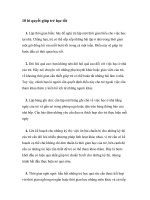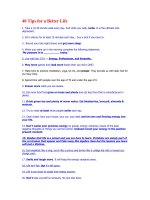Tài liệu 10 Tips for Creating Your Web Site ppt
Bạn đang xem bản rút gọn của tài liệu. Xem và tải ngay bản đầy đủ của tài liệu tại đây (143.22 KB, 8 trang )
10 Tips for Creating
Your Web Site
1-800-COURSES
www.globalknowledge.com
Expert Reference Series of White Papers
Introduction
When looking for ways to build of your web site, even minor steps can make a huge difference. The most helpful
information and best content will have little impact without simple protocols that make your Web site easier to
use and more visually appealing. This paper focuses on 10 tips you can employ to ensure your web site is effec-
tive from the day it goes live.
1. Accessibility
Web site accessibility has recently become a very important issue in the web community
. Because of Section
508 of the Rehabilitation Act of 1973, all web sites and pages created by Federal agencies and Federal contrac-
tors after June 21, 2001 must comply with its provisions. The purpose of the law is to make web sites accessi-
ble to all individuals
, including those with disabilities. The World Wide Web Consortium (W3C) developed Web
Content Accessibility Guidelines (May 1999), which expand the scope of Section 508.
This is very important to all web developers, whether you are a government agency, a contractor who does
work for the government, or a private firm with its own web site. An accessible web site refers to any content
or information provided via an online medium that all individuals (including those with disabilities) could easily
access and understand. Disabilities include not only visual impairments, but auditory, cognitive, and physical
impairments as well. They can range from very severe (total blindness, for example) to something as simple as
the increasing inability to see contrasts that develop as we age. Greater accessibility means more people can
fully utilize your web site’s features.
There are a number of aids available for enhancing accessibility. These range from programs like Jaws or IBM’s
Home Page Reader—which read the page aloud for the visually impaired—to sip-and-puff systems for the
quadriplegic. It is up to the web developer to create pages that allow these systems to provide an equivalent
alternative for these individuals
.
T
hink of accessing a web page as being similar to a play or opera. If you read
the script without benefit of the actors’ interpretation, lights, scenery, or music, you are only experiencing one
aspect of the author’s intent. The same is true of web access: if you can only hear the words being read, for
example
,
with no description of the images on the page or other visual components
, you would not fully expe-
rience the information being provided on the page. That is why, when we include an image, it is important to
use the “alt” attribute to provide a description of the image. This enables a screen reader to read this informa-
tion aloud for a visually impaired user.
There are several other tips like using <th> table headers with tables of information, not just placeholders. Be
careful of using the colors red and green together because of red/green colorblindness. Use sounds with care.
Not everyone can hear, nor does everyone have speakers set up on their computers.
Provided by WestLake
10 Tips for Creating Your Web Site
Copyright ©2006 Global Knowledge T
raining LLC. All rights reserved.
Page 2
S
o how do you know if your web site is accessible? Go to and enter the URL for
a web page. This free application will test your page and let you know where it does not comply
2. Security
Security is crucial to the success of your web site. There are several steps you can take to minimize the risk
that your web sites will be subjected to a breech in security.
Security Updates
Be sure you are running the most current version of your web Server. Monitor your vendor updates, and per-
form regular maintenance.
Validate User Input on the Client and the Server
V
alidating user input on the client is great for user experience. However, you need to validate input on the
server side as well. Consider that there are tools that look and feel to your sever like a web site when in fact
they are actually designed to fake input such as passwords.
Audit Logs
Maintain and review server logs to check for suspicious activity.
Common Settings
Be sure to minimize the risk to your server by minimizing the things users can do on your server. For example,
don’t permit users to browse the directory structure of your site unless it’s necessary.
Lockdown Your Server
Most servers have standard development mode and then a production mode. For example, Microsoft’s Internet
Information Server (IIS) has a lockdown utility that minimizes the attack surface for your web site.
3.Web Server Statistics
How many visitors do you have? What pages do they frequent? What times do they log on? Utilize a web tool
to assist you in not only collecting these statistics but also analyzing and correlating them. Web tools, such as
Web Trends, will aid you in collecting and utilizing this knowledge to answer these questions about your site.
Build a web page that not only follows appropriate standards
,
but also drives repeat visitations
.
4. Dynamic Technologies Styles
Are the pages within your site beginning to feel and act a little plain? Would you like more ways to format
your documents and give users more interaction with them? If so, then your site could make use of languages
such as Cascading Style Sheets and J
av
aScript.
Cascading Style Sheets (CSS) technology gives you more control of page layout and the ability to control the
design of multiple pages on your site from a single file
.
Additionally
,
CSS allows you to develop more sophisticat
-
ed layouts, more font schemes, and even more interactivity for your pages than was possible using just HTML.
Copyright ©2006 Global Knowledge T
raining LLC. All rights reserved.
Page 3
J
avaScript techniques are needed to develop cutting-edge, interactive web sites. From opening windows to
image-flipping and form validation, Javascript can help you build exciting, dynamic web pages.
Integrating HTML, JavaScript, and Cascading Style Sheets techniques are collectively known as Dynamic HTML
or DOM Scripting. Utilizing all three languages allow you to fully exploit the capabilities of Netscape
Communicator, Firefox, and Microsoft Internet Explorer.
5. Efficient Use of Appropriate Design Software
In the past, many web developers eschewed graphical web editing packages and boasted of developing pages
using a simple text editor (for example, Notepad). There is still a place for text editors, but efficient designers and
developers both use appropriate design software, often manually tweaking the code. Such packages offer a what-
you-see-is-what-you-get (WYSIWYG) environment for designers and code-writing tools for developers. These have
the software-complete repetitive steps, and let designers and developers focus on what they do best.
There are many options, but here are some of the major ones:
Dreamweaver (Adobe, formerly Macromedia)
• The most popular package
• Offers both design (layout) and development (programming) support
• Supports all major server-side scripting languages (ColdFusion,
ASP
, PHP
, JSP), Javascript, XML, and
ASP.NET (VB.NET and C#)
• Integrates well with Adobe Flash and Adobe Fireworks (both formerly Macromedia)
GoLive (Adobe)
• Offers both design (layout) and development (programming) support
• Supports several scripting and markup languages (PHP, JavaScript, SVG-t, SMIL)
• Integrates well with long-standing
Adobe products (Photoshop
, Illustrator, InDesign)
FrontPage (Microsoft)
• Offers both design (layout) and development (programming) support
• Supports Microsoft JScript and ASP.NET (VB.NET and C#)
• Integrates well with
V
isual Studio .NET and the Microsoft Office Suite
Microsoft Visual Studio (Microsoft)
• Primarily provides development (programming) support
• Integrated Design Environment (IDE) for developing in .NET environment
• Supports .NET languages (primarily VB.NET and C#, but other extensions for other languages provided
by third parties)
Eclipse (open source)
• Primarily provides development (programming) support
• Integrated Design Environment (IDE) for developing in any environment, but mostly commonly used for
J2EE
• Supports a multitude of programming languages (not language-specific).
Copyright ©2006 Global Knowledge T
raining LLC. All rights reserved.
Page 4
6. Standards and Browser Independence
Web site development has come a long way. There are lots of new tools that will help with web-page design,
not to mention web sites that offer suggestions and ideas for making your web site absolutely incredible.
Probably the biggest movement is the increasing use of Cascading Style sheets to separate page content from
formatting. We are also seeing more sophisticated use of JavaScript to make pages more dynamic and, therefore,
more interesting. Along with this, the World Wide Web Consortium (W3C) has instituted an effort to standardize
how browsers handle the display of web pages through the use of XHTML. It is hoped that among all of these
initiatives, programming for the web will become less a matter of making sure our pages work on all browsers by
testing against each one, and more one of creating web pages that are useful, accessible, and exciting.
There are a vast number of resources on the web to help improve web sites. For information about the new
XHTML standards, as well as help with Cascading Style Sheets and DOM Scripting (using JavaScript to make
your web pages more dynamic), the W3C pages () are invaluable. They include examples
and tutorials, both of which are very well done. For some wonderful examples of Cascading Style Sheets, we
recommend CSSZenGarden.com (http://www
.csszengarden.com). The organization that runs this site supplies
an html page with the required content. Designers are invited to create an external style sheet to format the
page. New contributions are regularly posted.
Another excellent resource is amicdrive
.com. The Internet group on Google groups
, formerly
Deja,
is helpful as well. The good news is that you can post a question
through Deja/Google groups. Within 24 hours you will usually get one-to-three technically correct answers.
Other potential resources include:
This is a solid resource for most scripting/programming languages and is top-notch for Java.
This is another language resource and is especially helpful with Microsoft .NET technologies.
This is the definitive place to get ASP or ASP.NET information.
http://www
.php.net A good resource for php.
http://www
.news.com CNET news.
This site keeps you up-to-date on IT news.
http://www
.theinquir
er.net
This site provides a hardware outlook for six months to a year-and-a half.
7. Database Access with Server-side Scripting Languages
Static web pages are good place to start,
but they quickly can become time intensive and not an efficient use
of a designer or developer’s time. Database-driven web sites can refresh their own data, presenting up-to-the-
Copyright ©2006 Global Knowledge T
raining LLC. All rights reserved.
Page 5









